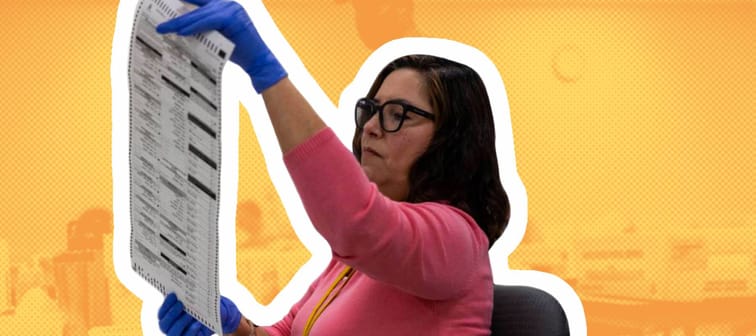Just the beginning
Travel costs and logistics alone for people who live in states with bans can be prohibitive.
And limits to local access disproportionately affect lower-income women, says Caitlyn Myers, economist at Middlebury College, because they can’t easily travel to another state to seek an abortion. And that is just where the gap begins to grow.
Gender gaps in the labor market often don’t emerge until people become parents, says Myers.
“And at that point, not much happens to men's earnings and women's really fall off a cliff,” she says. “They fall by about 33%, and this gap opens and they really never recover from that.”
Carrying an unwanted pregnancy to term widens that gap for years to come for lower-income women, says Myers.
“They are particularly economically fragile.”
Lower-income women are unlikely to have paid parental leave or have access to quality child care, especially if they’re shift workers. They’re also not likely to be able to take time out of the labor force when they do have a child.
“The social safety net in this country, for women who don't work, is almost non-existent, like welfare benefits are kind of laughably low,” says Myers, noting that welfare is just $220 a month.
Meet Your Retirement Goals Effortlessly
The road to retirement may seem long, but with WiserAdvisor, you can find a trusted partner to guide you every step of the way
WiserAdvisor matches you with vetted financial advisors that offer personalized advice to help you to make the right choices, invest wisely, and secure the retirement you've always dreamed of. Start planning early, and get your retirement mapped out today.
Get StartedThe impacts are felt for decades
Myers was the lead author on a brief signed by 154 economists and sent to the Supreme Court in September 2021, outlining the economic hardship overturning Roe v. Wade would bring.
She says that throughout their lifetimes, about a quarter of women in the U.S. have abortions. And because people who can afford it will still be able to seek an abortion in states where it’s legal, the inequality gap is just going to grow.
“This critical group, [currently] of about 100,000, in my estimate, of the poorest women, predominantly living in the banned states, they won't be able to find a way” to access safe abortion, she says.
“They're going to get blocked off from … a critical means of reproductive autonomy that other American women enjoy. And their lives will be impacted as a result.”
Studies show the impacts are felt for decades.
“Women are more likely to be poor, their current children are more likely to face insecurity and suffer, more likely to stay tethered to [their] abuser — there's all these range of impacts,” says Leila Abolfazli, director of federal reproductive rights at the National Women’s Law Center.
“Part of it is just common sense — what it's like when someone is struggling to make ends meet and then they're forced to carry a pregnancy to term — and in a country that really falls short on the range of things that it could do to support women and families.”
Insurance implications
Even before Roe v. Wade was overturned in June, coverage for an abortion was complicated. The Hyde Amendment, which has been in effect since the 1970s, forbids federal money from being used to fund abortions — except in cases of rape, incest or when a person’s life is in danger.
A 2019 report on abortion coverage by the Kaiser Family Foundation found the cost of the procedure varies depending on where and when it takes place and how it’s done.
The median cost at 10 weeks gestation was $500, while at 20 weeks gestation it costs about $1,200.
In more than 30 states, Medicaid programs don’t cover abortions outside of the Hyde exceptions. And many states impose abortion coverage restrictions on insurers, such as limiting coverage to cases of life endangerment.
Some insurance plans may cover out-of-state procedures in the wake of the recent Supreme Court decision, but it’s complicated and too soon to tell, says Abolfazli.
“Our system wasn't set up for a major health care service to be [lawfully] dependent on the state you’re in when people do travel for health care, and especially now they'll be traveling for abortion care,” says Abolfazli.
Stop overpaying for home insurance
Home insurance is an essential expense – one that can often be pricey. You can lower your monthly recurring expenses by finding a more economical alternative for home insurance.
SmartFinancial can help you do just that. SmartFinancial’s online marketplace of vetted home insurance providers allows you to quickly shop around for rates from the country’s top insurance companies, and ensure you’re paying the lowest price possible for your home insurance.
Explore better ratesLong-term financial consequences
As the immediate costs and barriers stack up, it becomes clear to see how easy it is for women who are denied access to an abortion to fall behind.
A landmark "Turnaway" study began in 2007 and followed more than 1,000 women from 21 states over several years. Some participants had access to abortions, while others were denied.
Led by demographer Diana Greene Foster, the research team from the University of California, San Francisco regularly interviewed the participants.
“The harms of being denied an abortion last for years,” says Foster in an email.
Most of the women followed in the study were in their 20s, already had children and felt at the time they weren’t in a position to have another.
“Five years after seeking abortion, those who were denied were more likely than those who received abortions to report that they lack enough money to pay for basic living needs,” says Foster.
Women who were denied an abortion were almost four times more likely to have a household income below the federal poverty line and were three times more likely to be unemployed than the women who’d been able to access an abortion.
And the impact showed in their older children. Mothers who had been turned away from receiving an abortion didn’t bond as well with their children, who were also more likely to be identified as living in poverty.
The mothers were more likely to not have enough money to pay for basic necessities like food, housing and transportation and they were more likely to stay in contact with violent partners.
“It's not theoretical,” says Abolfazli, at the Women’s Law Center. “It's real people's lives, and we keep seeing the stories and it's so gutting, because it's so preventable, right? Like, this is a man-made crisis to its core.”
Sponsored
Follow These Steps if you Want to Retire Early
Secure your financial future with a tailored plan to maximize investments, navigate taxes, and retire comfortably.
Zoe Financial is an online platform that can match you with a network of vetted fiduciary advisors who are evaluated based on their credentials, education, experience, and pricing. The best part? - there is no fee to find an advisor.







